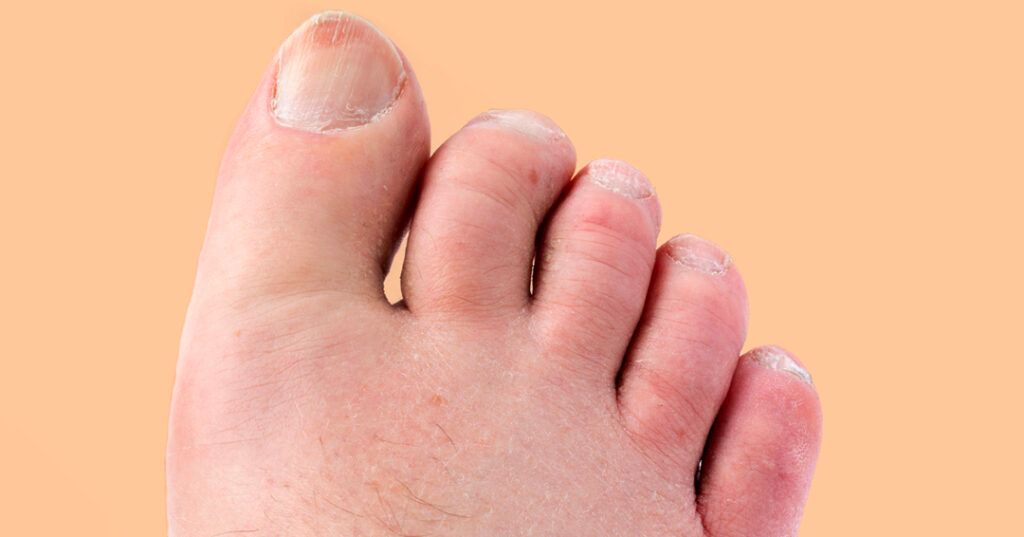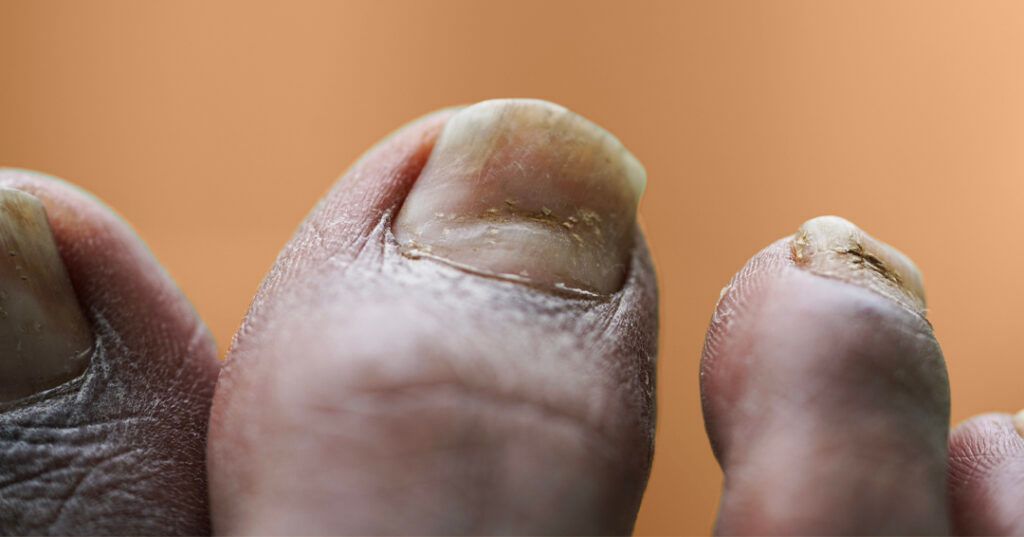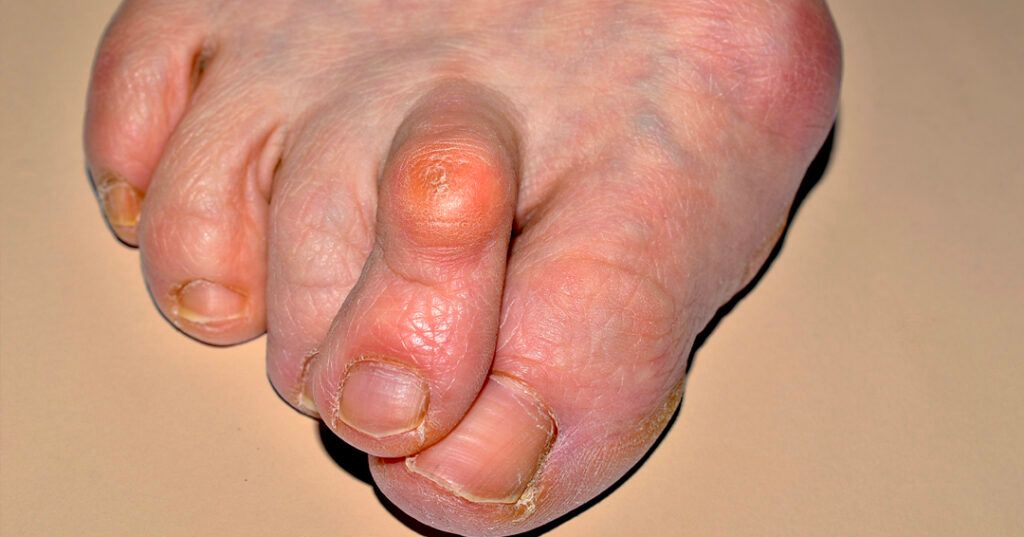Can You Get Psoriatic Arthritis in Your Toes?
Updated February 29, 2024
Content created for the Bezzy community and sponsored by our partners. Learn More

Photography by Maite Pons/Stocksy United
If you live with psoriatic arthritis, you may experience swelling, decreased mobility, and nail changes in your toes. Here are tips for supporting your toe health.
If you’re experiencing toe swelling and have psoriatic arthritis (PsA), you may wonder if the two are connected.
Psoriatic arthritis can cause joint pain, swelling, and stiffness throughout your body, including your toes. You may experience discomfort and problems with mobility in your feet. But there are steps you can take to treat symptoms.
Here’s what you need to know about how PsA can affect your toes and what you can do to manage symptoms.


How can PsA affect your toes?
PsA can cause distinct symptoms, like changes in the size or shape of your toes. You may also notice changes on the surface of the toenail or the nailbed.
Swelling (dactylitis)

Dactylitis is when a finger or toe swells due to an underlying condition or inflammation.
PsA can cause “sausage toes,” a type of dactylitis with severe and uniform swelling. It may be hard to tell whether the toe joint or other tissue is inflamed.
Dactylitis of the toes can be either acute (short term) or chronic (long term).
With acute dactylitis, your toe may be swollen and tender. It can appear discolored, for example, reddish on light skin. With chronic dactylitis, your toe may not be tender but may be swollen. This is also called “cold” dactylitis.
I’ve found that cold packs, compression socks, and supportive shoes have helped my toe pain. I wear the socks for as long as I can stand it and run cold water over my toes after a warm shower.
— MrsFork
Dactylitis is also a sign of enthesitis, or swelling of the entheses. These are areas of your body where tendons and ligaments enter bone. According to the Arthritis Foundation, 1 in 3 people with PsA develop enthesitis.
Pitted toenails (nail psoriasis)

PsA can also lead to changes in your toenails. In rare cases, it can lead to nail loss.
Signs of psoriasis in the nails include:
- nail pitting, or dents in the nail surface
- discoloration of the nails
- buildup or blood under the nail
- nail disintegration or crumbling
- separation or disconnection of the nail from the toe
Nail pitting is one of the the most common sign of psoriasis in your nails. These small dents are of even size and depth but may have a random arrangement.
Not all nail pits are from psoriasis or PsA. Ten pits in one fingernail or toenail or more than 50 pits combined in all nails are evidence of psoriasis.
A rarer form of nail psoriasis called acrodermatitis continua of Hallopeau (ACH) can lead to severe symptoms if not treated. ACH is more common in fingernails than toenails. In either case, it can lead to nail loss and osteolysis (loss of bone tissue) in the digit.
Hammer toes

If you live with PsA, you may also notice your toes shorten or take on a claw-like appearance. This is called hammer toe, where the toe is bent at the middle joint.
Hammer toes come with signs and symptoms, such as:
- changes in the color of your toe
- pain while walking
- trouble straightening your toe
If you experience hammer toes, wearing shoes that cover your toe can lead to corns or calluses on the toe with the bent middle joint, as it rubs against the interior of your shoe. Wearing comfortable shoes can help.
How to manage symptoms of PsA in your toes
PsA is a treatable condition. You can manage its effects on your toes with medical treatment and lifestyle measures.
- Follow your PsA treatment plan: Treating PsA overall can reduce symptoms in your toes. You may already be prescribed disease-modifying antirheumatic drugs (DMARDs) or biologics for long-term management. Over-the-counter anti-inflammatories like ibuprofen can also offer temporary symptom relief.
- Choose exercise that’s easy on the joints: Staying fit can help keep your joints flexible. It can also help to maintain a weight your joints can handle without putting extra strain on the toes. Consider joint-friendly exercises like swimming, water aerobics, and gym equipment like stationary bikes and ellipticals.
- Use cold therapy: Cold can reduce inflammation. Apply cold packs or a bag of frozen vegetables covered in a cloth to your toes for 10 minutes at a time. This can help reduce the swelling and pain associated with PsA in the toes.
- Wear comfortable and supportive shoes: Opt for open-toed shoes when you can to prevent crowding of swollen toes. Shoes with proper support and cushioning can help ease heel pain.
- Consider custom orthotics: Orthotics tailored to your individual foot needs may help ease foot pain. A small 2022 study found custom orthotics provided some pain relief and improved foot function for people living with PsA.
- Trim your toenails: Short toenails can help prevent the nail from scratching the surrounding tissue and causing a flare. Cut your toenails to keep them in check, but don’t trim them so short they cause bleeding.
When to contact a doctor
Speak with your doctor if your PsA toe symptoms are severe or don’t get better with lifestyle measures and home treatment. Your doctor may recommend remedies like:
- antifungal medications if you have a nail fungal infection
- cortisone injections to reduce swelling
- changes to your PsA treatment plan
Takeaway
Psoriatic arthritis can cause your toes to swell and toenails to pits, among other symptoms. Following your PsA treatment plan and using home remedies like cold therapy can reduce inflammation and relieve swelling and pain.
If your toe pain doesn’t improve or makes it difficult to get around, talk with your doctor about finding a new treatment plan.
It can also be helpful to connect with others who have PsA. The Bezzy PsA community understands what you’re going through and is here for you.
Originally written January 03, 2023
Medically reviewed on February 29, 2024
11 Sources


Like the story? React, bookmark, or share below:
Have thoughts or suggestions about this article? Email us at article-feedback@bezzy.com.
About the author